

FIG Annual Review
|
Contents |
|||||||||||||||||||||||||||||||||||||||||||||||||||||||||||||||||||||||||||||||||||||
|
|||||||||||||||||||||||||||||||||||||||||||||||||||||||||||||||||||||||||||||||||||||
President's Reportby Prof. Peter Dale
|
|||||||||||||||||||||||||||||||||||||||||||||||||||||||||||||||||||||||||||||||||||||
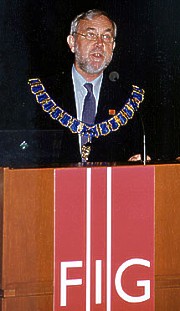 |
1999, the last year of the Millennium, marked the start of a new era for FIG. It began with the opening of our Permanent Office and the establishment of FIG as a legal entity. It closed with the handover of responsibilities for FIG from the UK to the US Bureau. At the end of May our South African friends hosted our Working Week while in October we published the Bathurst Declaration, a document prepared by representatives of FIG working in partnership with colleagues from five United Nations Agencies, the World Bank and a variety of professions. The Declaration sets an agenda for the creation of a more just world that operates more efficiently and effectively. It firmly links land administration to long-term sustainable development in which we are all mutually inter-dependent stake holders. It recognises that globalisation raises issues not just about markets and commercial activities but also about our own social and cultural survival. The recommendations in the Declaration cover only some of the activities in which FIG members take part – FIG covers many fields and as a multi-disciplinary group of people its whole is greater than the sum of its parts. |
This issue of the FIG Annual Review includes a resume of the period
1995–1999 during which the UK was responsible for managing the affairs of
FIG. In handing over the care of the FIG to the US Bureau I am confident
that a platform for a great future is in place. For that I must thank my
fellow Bureau members and many Commission Officers. We in the UK Bureau
have been able to stand on the shoulders of giants. I believe that we have
raised the platform just a little bit higher. We have a financially viable
permanent office with an excellent Director. We have some great people in
our Commissions. We have a growing awareness amongst our member
associations that at the national and local levels actions are not only
desirable but are possible. And we have a new Bureau that is excited by
the prospect of running FIG for the next four years.
The start of the next millennium could be the most challenging time in the
history of FIG. I wish my successors well and FIG every good fortune.
|
|
The highlight of the FIG activities in 1999 was a two-week period in October in Australia. During these days the joint United Nations and FIG Workshop to prepare the Bathurst Declaration on Land Tenure and Cadastral Infrastructures for Sustainable Development was held in Bathurst followed by the International Conference on the same subject in Melbourne.
 |
The opening ceremony of the Bathurst Workshop. |
The high-profile workshop in Bathurst was attended by 40 land administration experts from 23 countries, representing all continents and expertise on land, water, tenure reform, indigenous rights, women’s rights, the information revolution and government/institutional reform. Among the participants were representatives from six UN Agencies including United Nations Department of Economic and Social Affairs (Division for Sustainable Development), United Nations Centre for Human Settlements (Habitat), United Nations Food and Agricultural Organization (FAO) and the World Bank. FIG was represented both at the Bureau and Commission level. Special thanks for the arrangements go to Prof. Ian Williamson and Prof. Don Grant who were in charge of the workshop and the conference and to the many sponsors that made the events to come true.
The aim of both events was to explore humankind–land relationships in the next millennium in the context of Agenda 21, a product of the UN’s 1991 Rio de Janeiro conference, and the emerging global village. It determined a broad vision and a set of guidelines for legal, technical and institutional cadastral infrastructures and systems to support land management and in particular land administration to ensure sustainable development. The 21 recommendations designed to ensure that the world’s land administration structures are capable to meet the challenges of sustainable development. The challenges were identified as:
The Bathurst Declaration states that there is an urgent need to strengthen the policies, institutions and infrastructure needed to achieve effective access to land and property. It calls on the international community to support an ambitious, long-term programme of positive action to significantly reduce the number of people around the world currently denied secure access to land and property rights – aiming as an initial target to halve the number by 2010.
There is a particular need to focus on women, who accounted for half the world’s population but own only one per cent of the world’s wealth. The lack of secure property rights inhibit investments in housing, sustainable food production and access to credit and hinder good governance and the emergence of civil societies. It also reinforces social exclusion and poverty, undermine long-term planning and distort prices and land services. The role of land administration in supporting sustainable development has significant implications for the administrative structure of government, private sector activities and individual rights/responsibilities.
As a conclusion from the declaration “without effective access to land and property, market economies are unable to evolve and the goals of sustainable development cannot be realised. Without appropriate land administration systems sustainable development is simply rhetoric.”
The Bathurst Workshop was followed by the UN/ FIG Conference attended by over 300 delegates from thirty countries and in which the Bathurst Declaration was launched. The conference was opened by the United Nations Director of Sustainable Development, Ms JoAnne DiSano and among key-notes there was a presentation by Ms. Sherryl Garbutt, the Victorian Minister for Environment and Conservation.
The conference was further followed with a round table between FIG and five UN agencies and other international partners. The discussions focussed on implementation of the Bathurst Declaration and other FIG/UN Co-operation during 2000–2003. These negotiations will be implemented by bilateral agreements and memoranda of understanding.
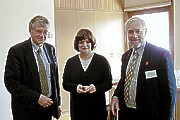 |
JoAnne DiSano, UN-DESA together with Prof. Peter Dale and Prof. Ian Williamson at the FIG/UN round table in Melbourne. |
The Bathurst Declaration was welcomed very warmly from the start and it will be translated to several languages like the former FIG publications on cadastre and land administration. It will be presented e.g. at the 8th Session of UN Commission on Sustainable Development in New York and at the 1st Session of the Preparatory Committee for Istanbul+5 in Nairobi already before the Declaration will be adopted by the FIG General Assembly in Prague in May 2000. The Declaration as well as the background papers presented at the conference in Melbourne are available on the FIG home page (www.fig.net).
|
|
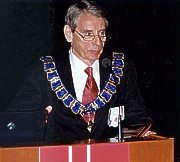 |
The administrative responsibilities for FIG have been handed over from the retiring United Kingdom Bureau to the new United States Bureau. The new Bureau will strive to extend the work done by our predecessors while also concentrating on the items of our Plan of Work we consider most important. Supporting, encouraging and where necessary, cajoling and exhorting the FIG commissions must always be one of the prime responsibilities of a Bureau. Each commission has its own Plan of Work and working groups assigned to carry out its goals. We on the Bureau will enjoy watching the progress of the commissions and their working groups and we look forward to great accomplishments in the coming years of our term and the terms of the commissions. |
Our predecessors the UK Bureau and their predecessors, the Australian Bureau, have established FIG in the eyes of several global agencies as an organization that defines its goals clearly and delivers – as promised and on time. The FIG/UN Roundtable meeting held in Melbourne in October 1999 established a program of FIG/UN activities for the period 2000 through 2003 . The Roundtable defined the relationship between FIG and several world bodies, including UNCHS (Habitat), UN Food and Agriculture Organization (FAO), UN Commission for Sustainable Development, UN/ECE Working Party on Land Administration (WPLA), the Permanent Committee on GIS Infrastructure for Asia and the Pacific (PCGIAP), the UN Economic Commission for Africa, the Permanent Committee on GIS Infrastructure for the Americas, the World Bank, and the German Agency for Technical Cooperation (GTZ) as representative of the national aid agencies. FIG “will work in partnership with various UN agencies to progress issues of common interest in their respective work plans” according to guidelines set forth in the roundtable report. It is a large order but the Bureau is committed to carrying forward this important work. We will be realistic and practical, however, and will identify those tasks and projects that are within our capacity to complete in a timely manner.
The US Bureau intends to make a major effort to encourage greater participation by our South and Central American neighbors in the activities of FIG. It is an effort begun by the UK Bureau and we will continue that effort.
We will do all that we can to involve the member organizations (MOs) of FIG more directly in the Federation’s activities. To begin with, there must be more and better communication between FIG and the MOs. Too often the work of the commissions goes no further than the individual delegates. But we are a federation of associations, not of individuals and to be a truly successful representative of the world’s surveying community FIG must address the concerns of all its members. We cannot do that as long as our member organizations are silent. I will continue to invite the presidents and executive officers of the MOs to our Working Weeks and the 2002 Congress, as President Peter Dale did during his term of office. In the meantime I invite the leadership of all member organizations to communicate their concerns and priorities to the Bureau through our office in Copenhagen. In turn I hope that the MOs will take advantage of an expanded FIG Bulletin as an opportunity to communicate to their members the activities of FIG.
And a word about our Copenhagen office: Finally, FIG is constituted as a legal entity with a permanent address. Our policy is to direct all communications between and among the Bureau, the commissions, the MOs, and the rest of the world through the permanent office. As a result inquiries will not go unanswered or overlooked and concerns will be directed to the party best positioned to deal with them. The office is fully equipped to deal with mail, phone, fax, voicemail, email, and the web and will adopt whatever new miracles of communication may emerge in the coming years. We want to hear from all our member organizations; and we hope or members will attend to all the activities of FIG with interest, support – even correction when that seems appropriate.
|
|
The handover between the UK Bureau and the new US Bureau took place in Washington, D.C. 8 November 1999. The ceremony was arranged at the headquarters of the National Geographic Society and preceded by a technical session on new experiments on GPS – presentations made by experts e.g. from NOAA and Intergraph.
At the handover ceremony welcoming speeches were made by Dr John Fahey, the President of National Geographic Society and Dr D James Baker, Administrator of the NOAA and Under Secretary for Oceans and Atmosphere at the U.S. Department of Commerce. The greetings from the hosting US member associations were presented by Prof. James Reilly, President-elect of American Congress on Surveying and Mapping (ACSM) while Michael Yovino-Young, Chair of FIG Commission 9 was representing the Appraisal Institute. The ceremony was attended by about 70 invited guests including people from government, private companies, FIG institutional partners and sponsors. It was especially delightful that members of the previous US Bureau 1973–75 were present led by William Radlinski, the Honorary President of FIG.
The highlight of the ceremony happened when Prof. Peter Dale presented the chain of office to the new President, Robert W Foster.
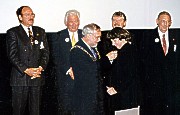 |
The new US Bureau starts it work by receiving their badges from President Peter Dale. |
|
|
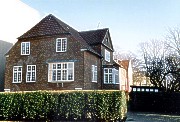 |
The permanent office of FIG was officially opened in conjunction with the Bureau meeting in Copenhagen in February 1999. Already the first year in action has shown that the decision made in Singapore in 1997 was the right one. The FIG office takes care of the day-to-day business of the Federation and has organised the administration on a continuous basis. During the first year of practice the information delivery of the Federation has been re-built by effective use of internet and email. The FIG web site (www.fig.net) includes among administrative issues and registers all FIG publications, bulletins, papers from the FIG working weeks and conferences etc. This, of course, does not mean that FIG has finished publishing its documents also as hard copies. |
The FIG office also offers good meeting facilities for Commission seminars and for administrative meetings of FIG and its bodies. During the first year the FIG office was visited by delegations from more than 10 member associations.
The permanent office is staffed by the Director, Markku Villikka and his personal assistant Jørgen Springborg.
|
|
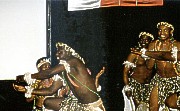 |
The 1999 working week and XXII General Assembly took place in Sun City, South Africa from 30 May to 5 June, when delegates from 37 member associations were present at the General Assembly. The Conference “Survey ‘99” under the theme “Africa: succeeding in the face of change” attracted over 350 participants from 43 countries – among them 13 African countries showing the expansion of FIG activities to the developing countries. The working week was the first FIG administrative meeting to be held in Africa for nearly 30 years and followed from seminars arranged jointly with other international organisations in Harare in 1995 and in Durban in 1997. |
The technical conference that was the main event for the technical commissions in 1999 consisted of 20 sessions and three workshops covering issues from all FIG nine technical commissions and ad hoc commission on construction economics. Technical excursions included GPS in a game park surrounding and a visit to Soweto on South Africa’s election day.
The most interesting issue on the General Assembly agenda was the report from the task force on the future governance and management of FIG. The proposal included suggestions for a directly elected bureau and separating responsibility for the Bureau from that of running the FIG’s quadrennial congress. There was a large support for the renewal of the current organisational framework and on elected President and Vice Presidents. The final report will be presented to the General Assembly in Prague and the new statutes for the approval of the General Assembly in Seoul 2001 so that the new governance structure will be partly operational from 2003 and in full operation in 2007 when all Council members are elected by the General Assembly and the Council is globally representative.
Decisions of the General Assembly included the ratification of bilateral agreements with other international organisations. These included memoranda of understanding between FIG and the International Cost Engineering Council ICEC which was signed at the opening ceremony and a similar agreement with the International Council for Research and Innovation in Building and Construction CIB which has already resulted in joint projects. The General Assembly endorsed also that FIG should terminate its membership of IUSM and instead seek to enter into bilateral agreements with each of its other members. IUSM itself was then disbanded in August 1999.
The General Assembly selected Athens, Greece to host the FIG working week 2004.
|
|
Commission 3 on spatial information management organised its annual meeting and seminar in Budapest, Hungary in October 1999 with 83 participants of which 31 came from outside Hungary. The seminar was opened with keynotes given by Jaime Vazquez-Caro from the World Bank and Fritz Rembold from FAO. The Hungarian Society of Surveying, Mapping and Remote Sensing used a lot of effort to organise a high quality technical seminar focusing on the problems in Hungary – very similar to other countries in transition – and representing totally 35 papers.
Commission 4 sponsored a one-day workshop at the 6th South-East Asian Hydrographic Conference that was held in Freemantle, Australia in November. Tom McCulloch, past chair of Commission 4, was a keynote speaker giving an informative presentation entitled “From Cook and Dampier to Y2K”. The workshop presented a broad range of papers covering topics from airborne laser mapping to using GPS for maintaining tidal data. The latter resulted in a resolution to the plenary of the conference to accelerate activities to establish an integrated network of tide gauges and GPS stations for absolute sea-level determination in South-East Asia.
The 22nd meeting of the FIG/IHO International Advisory Board on standards of competence for hydrographic surveyors was held in New Delhi in April. This Board has two primary responsibilities: the development and updating of the standards of competence for hydrographic surveyors and the recognition of courses given by educational institutions that meet these standards. The Board also produces a publication of the standards, which is currently in its 8th edition. FIG/IHO Technical Assistance Coordinating Committee held its 9th meeting during the US Hydrographic Conference in Mobile, Alabama in June.
Commission 5 organised an international seminar “Geodesy and surveying in the future” with a special focus on the subject the importance of heights. The seminar was organised in Gävle Sweden in March 1999. The seminar was co-sponsored by the Nordic Commission of Geodesy and the National Land Survey of Sweden and arranged to celebrate the 25th anniversary of introducing the motorised levelling technique in Sweden. About 120 participants from more than 20 countries contributed with more than 50 presentations during the three-day seminar. In addition to technical sessions there was an exhibition on height determination techniques and instrumentation from the past 50 years. This seminar was the first on heights organised in the Nordic countries and probably the only one in the world during the last decade. The objective was to give a complete overview and the state of art concerning height determination questions. The technical sessions covered the full spectrum of techniques, instruments and applications from purely scientific to practical end-users applications. The seminar was also the first attempt for Commission 5 to clarify its role as a link between the scientific community (IAG) and the practitioners and end-users.
Commission 5 also co-organised jointly with ISPRS and IAG the 2nd international workshop on mobile mapping technology in Bangkok, Thailand in April 1999.
Commission 6 working group on deformation measurement and analysis organised the 9th international symposium on deformation measurements in Poland in September that raised interesting discussions and conclusions on deformation models and the related terminology. A dedicated session of working group on facility management systems was included in the Turkish-German Joint Geodetic Days held in June. The 6th international workshop on accelerator alignment (IWAA) took place in Grenoble in October, with the joint support of commission 6 working group 6.3 and IAG SC4 covering a large scope of achievements and of instrumental development in this specialised field.
Commission 6 is further working to be the link between FIG and the International Society for Mine Surveying ISM. In addition commission 6 is considering to organise a joint workshop on surveying techniques for construction works with CIB.
The annual meeting and seminar of Commission 7 held in Bay of Islands, New Zealand in October 1999 was an outstanding success. The particular feature of the annual meeting that has become the commission’s trademark was the one-day international symposium, focussed this time on the work of the working group on women’s access to land generating a great deal of light on the subject. It was impressive not only by the quality of the papers and presentations but also by the genuine interest and enthusiasm of the large numbers of people attending. The material was considered of such quality by the New Zealand Institute that it has been formally published in the Institute’s Survey Quarterly. From New Zealand, a strong contingent of Commission 7 delegates went on to work as a part of the Bathurst Workshop on “Land Tenure and Cadastral Infrastructures for Sustainable Development”.
Commission 8 on spatial planning and development organised a three-day workshop in Rotterdam and the Ruhr District in September. The workshop attracted 17 experts from seven countries to discuss the framework, social questions, cost and benefit, environment issues and culture of landscape changing processes in the big cities of the Netherlands and the Ruhr District of Germany.
The ad hoc commission on construction economics and management organised a special technical symposium during the working week in Sun City attracting almost 40 delegates and during the week also the inaugural meeting of the African Association of Quantity Surveyors (AAQS) took place. Discussions included guidelines on standards and practice in construction economics and guidelines relating to the development of low-cost housing and its related infrastructures.
|
|
In addition to the joint United Nations and FIG Bathurst Workshop and the Melbourne Conference which resulted the Bathurst Declaration FIG had very close links with the United Nations and its agencies in 1999.
FIG attended the 17th Session of the Commission on Human Settlements UNCHS(Habitat) in May 1999. This was the first time that FIG attended an formal Habitat meeting in Nairobi. The focus of this meeting was on the arrangements for the Special Session of the UN General Assembly for Istanbul+5 to be held in June 2001. FIG was invited to the meeting as one of the main professional partners and was also invited to attend the Habitat roundtable on housing rights and security of tenure as one of the panelists. This special session was attended by over 100 of the total 600 participants of the 17th session. Afterwards FIG agreed to promote the main two Habitat global campaigns and especially focus on the security of tenure.
Among the parallel events during the 17th session was also a meeting where the Habitat Professionals Forum was established. Being one of the founding members of the Forum FIG was invited to nominate a member to the steering committee of the Forum. The idea of the Forum is to form a meeting place for all professionals to implement the Habitat Agenda and to promote co-operation between professionals, governmental bodies and the private sector. The Forum further aims to arrange its workshops and symposia in developing countries and in particular in megacities to help the professionals from these countries to participate the activities of the Forum.
A high-level delegation of FIG chaired by Vice President Robert Foster visited UNEP and UNCHS(Habitat) headquarters on their way to the FIG working week in Sun City in May. During this visit the first memorandum of understanding between FIG and Habitat for 1997–1998 was evaluated and its extension signed by Mr. Daniel Biau, the Deputy Executive Director of UNCHS and Vice President Foster. The extension of the memorandum for 1999 guaranteed the support of Habitat to the Bathurst workshop and also started preparations for a new protocol for 2000–2003.
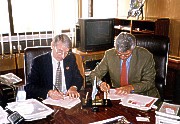 |
Daniel Biau, Deputy Executive Director of Habitat and Robert Foster, Vice President of FIG signed the extension of the MoU between Habitat and FIG in Nairobi in May. |
The Food and Agriculture Organization of the United Nations (FAO) is producing a thesaurus on land tenure issues. FIG was invited to produce the English version of the thesaurus that is already published in French and expected to be published in Spanish in the future. FIG and its Commission 7 agreed to participate in the project and the main responsibility of the English version was taken by Dr. Paul Munro-Faure, the chair of Commission 7.
Jes Ryttersgaard, chair of Commission 3, represented FIG at the 1st meeting of the Committee on Development Information (CODI) in Addis Ababa, Ethiopia in June/July 1999. The meeting was attended by more than 100 participants from African countries. Among the professional observers were FIG, ISPRS and ICA. The meeting was organised by the UN Economic Commission for Africa that has subsumed the functions of the former cartographic conferences for Africa by the newly created CODI. CODI has three sub-committees: information and communication technologies, statistics and geoinformation. Among the resolutions there is on capacity building that FIG should together with other professional organisations organise seminars on geoinformation management in Africa which seem to take place in 2001.
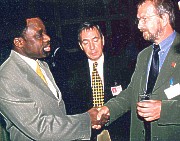 |
Jes Ryttersgaard, chair of Commission 3 (on the right) together with Dr. K.Y. Amoako, UN Under Secretary-General (left) and Executive Secretary of ECA and Orlando Nino Fluck from ECA at the CODI meeting in Addid Ababa. |
FIG Commission 3 has further more been active in establishing a project to create best practice guidelines for spatial information and knowledge management for decision support in urban management. This project is based on a set of six case studies that would be included in the Habitat’s best practice database in improving the living environment.
FIG was further represented at a regional workshop on land survey and large-scale mapping in support of settlement planning, land development and management that was held in Nairobi in October 1999, hosted by the Habitat and the Regional Centre for Mapping of Resources for Development (RCMRD). The workshop was aimed at enhancing and strengthening the basic tools and instruments for the effective functioning and sustained socio-economic and environmental management of cities and towns in Africa. Over 70 participants from various countries of Africa attended the workshop. FIG was represented by Robin McLaren, a working group chair of Commission 3.
|
|
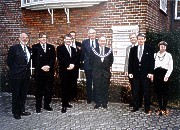 |
On 25 October 1995 the President of The Royal Institution of
Chartered Surveyors hosted a reception in London at which the
administration of FIG formally passed from Australia to the UK and
Professor Peter Dale took over from Earl James as President of the
Federation.
“Developing the profession in a developing world” was the theme that underpinned the UK Bureau’s work. Throughout its period of office the Bureau focused on |
The Bureau also recognised that markets for surveyors’ services are constantly changing: emphasis was accordingly placed on
This report summarises the work undertaken in furtherance of specific elements of the Bureau’s work plan, of which highlights included:
In May 1995 the Permanent Committee accepted in principle that, if FIG was to continue to function effectively, it needed to move on from the system of relying on a chief executive working voluntary and an administration which moved to a different country every four years. One of the first tasks of the UK Bureau was therefore to investigate the feasibility, including the cost, of establishing a permanent office.
From a short-list of five potential locations the Permanent Committee selected the headquarters of Den danske Landinspektorførening DdL (the Danish member of FIG) in Copenhagen. The UK Bureau, working in close collaboration with the incoming Bureau and with DdL, then established the frameworks within which the office would operate and be staffed. Following an international selection process, the post of office Director was offered to Markku Villikka, at that time Director of Planning for the Municipality of Hollola in Finland and immediate past chair of FIG Commission 8. He took up his post on 1 January 1999 and the office was officially opened in conjunction with a Bureau meeting held there on 3–4 February 1999. Its creation is probably the greatest challenge FIG has undertaken in its 120 year history; but the office is more than meeting the challenge in providing a complete range of support services, both administrative and financial, for FIG and hence for the world-wide surveying community. Great credit is due to Markku Villikka for having established the office and its international reputation so securely and so speedily; and to DdL and the wider surveying community in Denmark for the support which they have given and continue to give to this land-mark venture.
Recognising the need for a simplified constitution for FIG the UK Bureau commissioned a major revision of the existing Statutes. The resultant draft, comprising simplified Statutes and supporting Internal Rules, definitions of responsibilities and guidance notes, was submitted to an extensive consultation process prior to being approved by the General Assembly in 1998. Major changes include
The complete document was published in September 1998 as FIG publication no. 18 and posted on FIG’s home page.
The establishment of the FIG Office and the review of FIG’s constitution both suggested that FIG should consider making more fundamental changes to its management and operational structures if it was to function as a truly international NGO and meet the challenges of the 21st century. The UK Bureau therefore established a task force to examine possible options and report back during the period of the US administration.
This increased significantly during the period of the UK administration – partly because the Bureau was able to build on contacts established by its predecessors but also because the United Nations is increasingly involving non-governmental organisations (NGOs) and professional organisations in the preparation and execution of projects. To help manage the rapidly increasing scope and pace of FIG’s interaction with UN agencies, Ian Williamson was appointed Director, FIG/UN liaison in 1998. In this role he has helped to take forward projects initiated during the UK administration and he will subsequently advise the incoming Bureau and the FIG Director on other possible ways of furthering FIG/UN links.
In March 1996 FIG, with the support of the UN and of the Australian and Indonesian governments, organised an international meeting of cadastral experts in Bogor, Indonesia. The result was the Bogor Declaration, setting out desirable requirements and options for cadastral systems of developing countries and countries in economic transition.
Ian Williamson, then chair of Commission 7 and who had acted as technical co-ordinator of the Bogor meeting, represented FIG and presented papers on the Bogor Declaration and on the strategic management of cadastral reform at the two UN regional cartographic conferences that took place in 1997 – the Asia/Pacific conference in Bangkok in February and the Americas conference in New York in June. Both sets of resolutions clearly demonstrated that, in the view of the UN, good land management policies lie at the heart of sustainable economic growth and environmental management; and it was clear that the UN attached great importance to FIG’s on-going involvement in the development of such policies.
In January 1996 FIG participated in a meeting in New Delhi on access to land and security of tenure – one of the topics included in the Global Plan of Action to be adopted by the forthcoming HABITAT II Conference. The President of FIG was subsequently co-opted on to the steering committee dealing with NGO contributions to HABITAT II and invited to organise and chair the one-day seminar, “Dialogue 6 – land and rural/urban linkages in the 21st century”, that formed part of the HABITAT II programme.
HABITAT II, organised in Istanbul in June 1996 by the UN Centre for Human Settlements (UNCHS/Habitat), was a follow up to the Earth Summit in Rio 1992 which launched Agenda 21, the UN’s agenda for the 21st century. Surveyors’ contributions are vital to the success of many of the issues raised in Agenda 21 and the Global Plan of Action: in 1998 the Bureau therefore established a task force on sustainable development to assist FIG members to respond positively to both these important documents.
In January 1997 FIG signed a memorandum of understanding with UNCHS(Habitat), whereby both organisations would undertake collaborative projects in support of the Global Plan of Action and bring surveyors’ skills to bear on problems of human settlement, particularly in emerging economies. Activity in furtherance of the memorandum included contributions to the iKUSASA conference on land tenure and informal settlements held in Durban in August and a workshop on land tenure in West African francophone countries. Although FIG was prevented at the last minute from attending this workshop, its organisation nevertheless gave added impetus to the organisation of a Groupe Francophone of FIG’s French-speaking members which held its inaugural meeting during the Brighton congress.
The FIG/UNCHS(Habitat) memorandum was evaluated and extended during a visit to the UNCHS headquarters by FIG representatives, including the President-elect, the Director of FIG/UN liaison and the Director of the FIG Office, in May 1999. Amongst other initiatives, the extension formalised UNCHS’s commitment to the global workshop on land tenure and cadastral infrastructures to support sustainable development held in Bathurst, Australia, in October 1999. The genesis of this meeting between FIG and UN international and regional agencies concerned with land management and sustainable development was the 1996 Bogor conference which had recognised that a clearer definition was needed of the rights, responsibilities and obligations which attach to land.
 |
Dr. Sylvie Lacroux, UNCHS(Habitat) together with Robert W. Foster and Prof. Ian Williamson at the UN/FIG Melbourne Conference. |
The 1999 workshop resulted in “The Bathurst Declaration on Land Tenure and Cadastral Infrastructures for Sustainable Development” (FIG publication no. 22) which was formally presented to an immediately following three-day conference in Melbourne sponsored by the UN, the New South Wales and Victoria governments and the University of Melbourne’s Department of Geomatics. The conference focused on the legal, technical and institutional infrastructures that will be needed to support man/land relationships for the next millennium in the context of Agenda 21 and the Global Plan of Action.
Immediately following the conference, the senior officials from the seven UN agencies and the World Bank who had attended both that event and the Bathurst workshop took part in a round table with the President and other representatives of FIG. The discussions and outcomes of the round table are reported in “Co-operation between FIG and UN agencies, 2000–2003” (FIG publication no. 21).
The FIG Director attended the 17th Session of the Commission on Human Settlements in Nairobi in May 1999, the first time FIG had taken part in such a meeting as a UNCHS professional partner. He was invited to be one of the panellists at a round table on housing rights and security of tenure and was elected to the steering committee of the newly-formed Habitat Professionals’ Forum. One of the most important issues discussed at the bi-annual meeting was UNCHS (Habitat)’s future work programme, comprising global campaigns for secure tenure and on good urban governance. FIG’s input to both campaigns, and to the special session of the UN General Assembly, “Istanbul+5” in June 2001, will be addressed in an FIG/UNCHS plan of action for 2000–2001 to be signed when the present memorandum of understanding expires at the end of 1999. The possibility of involving the UN Environmental Programme in this new plan of action was also pursued during the FIG Director’s visit to Nairobi.
The Dialogue which FIG organised as part of the HABITAT II programme was sponsored by the International Real Estate Federation (FIABCI). Working together on this event convinced both organisations that their common interests in land and property provided plenty of opportunities for networking; and they therefore signed and a joint memorandum of understanding in 1997. Since then FIG has signed similar MoUs with the International Cost Engineering Council (ICEC) and the International Council for Research and Innovation in Building and Construction (CIB).
By the beginning of 1999 the Bureau had reluctantly decided that FIG derived insufficient value from its membership of the International Union of Surveys and Mapping (IUSM) to warrant the subscription payments. However, following FIG’s formal resignation, IUSM itself was disbanded. Options for maintaining links with its remaining members, following their agreement to establish a new Joint Board, will be reviewed by the incoming Bureau.
Work within the World Trade Organisation (WTO) to liberalise trade in services led the UK Bureau to commission a review of surveying occupations and activities and the way these are currently defined within the two main UN international classifications. Suggestions for improvements to both classifications, when they are next up-dated, have been discussed with the responsible officers in the UN Statistical Department and the ILO. An FIG task force on mutual recognition of qualifications was also established, to review existing qualifications within the world-wide surveying community, develop a framework for the introduction of guidelines of global professional competence for surveyors and interact on FIG’s behalf with the WTO.
Throughout the period of the UK administration FIG has been involved in the work of the International Standards Organisation (ISO) as this relates to geomatics and geographical information. An FIG task force on standards was established to manage FIG input to ISO and to prioritise all necessary FIG involvement in other standards activity.
The review does not detail the work of the FIG commissions, whose operating cycle runs from congress to congress. Their activities over the period 1994–1998 were published and circulated with the 1998 FIG Annual Review and similar reports will be published for the period that will conclude with the 2002 congress. It is, however, to mention two initiatives. The first is the work of the Advisory Committee of Commission Officers (ACCO), comprising chairs and vice-chairs of commissions, whose meetings are now a regular – and important – feature of FIG working weeks. Its importance as a source of ideas and support was well demonstrated by the additional special meeting which was organised between ACCO and members of the UK and incoming US Bureau in January 1998, to co-ordinate the preparation of commission work plans for the period 1998–2002 and develop a strategic plan for FIG.
The second initiative was the establishment of an ad hoc commission on construction economics – an activity which forms part of the FIG definition of a surveyor but which was not included within the remit of any of the existing commissions.
Commission chairs for 1994–1998:
The International Institution on the History of Surveying and Measurement – a permanent institution of FIG – was established in 1998 to continue the work of the former ad hoc commission on the history of surveying. Its art and history of surveying exhibition and symposium were popular and well-attended adjuncts to the 1998 FIG congress. One of its more important current projects is its work with UNESCO to get the 19th century Struve arc preserved as an international heritage monument.
The Office International du Cadastre et du Régime Foncier (OICRF) has continued its work and in 1997 published a marketing plan for the 21st century. The FIG Multi-Lingual Dictionary Board up-dated and published 10 of the 15 volumes that make up the 197l edition of this dictionary; its work also continues. Because the FIG office took over responsibility for the FIG archives, that permanent institution was wound up.
There were no substantial increases in the number of FIG’s member associations during the period 1996-1999; but significant changes were made to the membership structure. The first change opens membership of FIG to any association, be it representative of one or all of the disciplines of surveying, whose members possess relevant academic and professional qualifications and provide professional services in accordance with ethical standards. The category of affiliate member – defined in the new Statutes and Internal Rules as “an organisation comprised of individuals who practise the profession of surveying but which does not fulfil the criteria for membership as a membership association” – enables FIG to work with such organisations and thereby assist professional development in their respective countries. The category of academic member was created in recognition of the contribution which teaching and research institutions make to the development of the profession. The fact that 15 university departments have joined FIG in the five months since this category of membership is indicative of the value which the academic community attaches to FIG. The Academic members of FIG at the end of 1999 were:
The following appointments were made at FIG’s General Assemblies in 1998 and 1999:
At the conclusion of the UK administration of FIG the membership consisted of:
Stemming from a suggestion that FIG should do more to support the role of women in surveying, in 1997 the UK Bureau established a task force on under-represented groups in surveying to encourage greater participation in professional activity by women, young surveyors and other under-represented groups.
To help surveyors meet the needs of the markets and the communities that they serve the UK Bureau commissioned four FIG publications: “Continuing Professional Development” (no. 15), “Constituting Professional Associations” (no. 16); “FIG Statement of Ethical Principles and Model Code of Professional Conduct” (no. 17); and “Quality Assurance in Surveying Education” (no. 19).
A practical example of how FIG can assist professional development is the influence which the Bureau and the then chair of Commission 2 brought to bear, at the request of FIG’s member association in Sri Lanka, on that country’s government, resulting in the establishment in 1998 of a first degree course in surveying at the University of Sabaragamuwa.
The President and other members of the UK Bureau have managed to visit most member associations – either en route to and from FIG meetings or in conjunction with their own business travel. To encourage the member associations to become more involved in FIG’s decision-making processes the President of FIG organised an informal meeting during the 1998 congress with the Presidents or their representatives of more than 40 member associations. This was judged a great success and a similar meeting was therefore arranged during the 1999 working week.
Also in 1998 and 1999 Bureau members held several meetings with FIG’s
sponsor members. Sponsors make an important contribution to the work and
development of FIG and it is therefore important that they derive maximum
benefit from their membership of the Federation. Berntsen International
Inc and Kampsax
A/S joined FIG as sponsor members in 1995–1999.
The new quarterly FIG Bulletin was introduced by the UK Bureau, using a format which encourages member associations to abstract information to pass on to their individual members via their own journals. The Bulletin is produced as a published document; since the beginning of this year it has also been placed on FIG’s home page.
Another new venture was the FIG Annual Review, a 12-page high quality publication containing a brief resumé of the year’s events and directed mainly at clients of surveyors’ services. Two information leaflets and three FIG publications, in addition to those already mentioned, were published by the UK Bureau: FIG’s Plan of Work 1996–1999 (no. 12); “Land Tenure, Land Management and Land Information Systems” (no. 13) – the report of FIG/UN round table meetings in August 1995; and “Working Towards Liberalisation in Trade in Services” (no. 14). The popularity of the FIG Statement on the Cadastre, prepared by Commission 7 and published by the Australian Bureau as FIG publication no. 11, is evinced by its translation to date, mainly by member associations, into a total of 20 languages; and similar best-seller status is predicted for Commission 7’s companion publication on reforming the cadastre, “Cadastre 2014”.
The proceedings of several of the seminars organised by FIG’s commissions were also published and most of the commissions now produce their own newsletters.
It is electronic media that have facilitated the most important development in FIG communications, particularly since the establishment of the FIG office. An FIG home page has been established: news flashes, press releases, the quarterly FIG Bulletin, meetings information and all administrative documents are now placed on the home page as well as being delivered by post. Linkages have also been set up between the FIG home page and those of the commissions, the members and allied professional bodies.
FIG working weeks were held in Argentina in April 1996, Singapore in May 1997 and South Africa in May/June 1999. In 1998 administrative meetings were combined with the XXI International Congress of Surveyors, hosted by The Royal Institution of Chartered Surveyors in Brighton, UK in July and providing more than 1,000 delegates and their guests from 80 countries with their best-ever opportunity for global networking, with each other and with an equal number of day delegates and visitors to the largest exhibition ever to have been staged as part of an FIG congress. Care was taken to cite the exhibition at the very centre of the Congress venue – a facility welcomed by exhibitors and visitors alike. The commission sessions were complemented by three open forums which brought surveyors of all disciplines together to discuss the impact of technology, sustainable infrastructures and the global property market with acknowledged experts in these three fields. Another notable success of the congress was the sponsorship, by FIG and others, of young professionals from eastern Europe, some of whom were meeting surveyors from outside their own country for the first time.
A detailed account of the congress and copies of the presented papers are contained in the 10 volumes of the published proceedings.
Most of the commissions organised meetings additional to their congress sessions and the seminars which they ran during FIG working weeks. Commission 7 has established the practice of holding an annual meeting and accompanying seminar and Commission 3 is moving towards doing the same. Commission 2 runs a mid-term workshop and seminar, inter alia to facilitate the development of the incoming chair’s work plan; Commissions 5 and 6 tend to organise their workshops and symposia jointly with allied scientific organisations; in 1997 they also joined with Commission 4 in running a symposium in Denmark.
Moving FIG’s administration from country to country every four years meant that each Bureau started work from a zero financial base. This, coupled with the need to increase subscription income to meet the cost of an ever-increasing work load, led to the establishment of a task force to review FIG’s financial structure. As well as recognising that the FIG office will provide some much needed continuity in the management of FIG’s finances the task force made several recommendations for augmenting subscription income. The resultant regular, albeit modest, annual increases in rates, coupled with the introduction in 1998 of a sliding scale of maximum subscriptions payable by associations with more than 4,000 members, are expected to keep income and expenditure in balance for the foreseeable future.
The UK Bureau increased the amounts of annual grants paid to the commissions. and instituted a system of accounting for commission grants, partly to identify the support which commission chairs receive from other sources and the funds which they personally commit to their work for FIG.
The Foundation, established by the Australian administration of FIG, continued its fund-raising activities and at the end of its 1999 accounting year held total assets of $27,790.55. It has established policies for the distribution of funds, which will start once the principle balance reaches $100,000.
The UK Bureau cannot conclude this review without acknowledging the debt which FIG owes to so many organisations and individuals. On-going thanks are due to DdL for its support of the FIG office. The RICS underpinned the work of the UK Bureau before and throughout its period of office; ran a highly successful FIG congress; and supported both the establishment of the FIG office and FIG’s work with other international organisations. Nearly all member associations and many governments assisted delegates to participate in FIG business and sponsored FIG meetings. Commission officers, task force chairs, directors of permanent institutions, national and commission delegates, and a host of other individuals gave unstintingly of their time; and their contributions to the work of FIG was often at their own expense.
FIG could not function without the dedicated support of so many people throughout the world. This dedication, coupled with the continuity of administration that will be provided by the FIG office, will stand the Federation in good stead as it moves into the next century.
|
|
Algeria
Association des Géomètres Algériens
Argentina
Federación Argentina de Agrimensores
Australia
The Institution of Surveyors, Australia
Austria
Austrian Society for Surveying and Geoinformation
Bahamas
Bahamas Association of Land Surveyors
Belarus
Belarus Land Reform Association *
Belgium
Union Belge des Gèomètres-Experts Immobiliers
Bulgaria
Union of Surveyors and Land Managers in Bulgaria
Canada
Canadian Institute of Geomatics
China
Chinese Society of Geodesy, Photogrammetry and Cartography
Croatia
Croatian Geodetic Society
Cyprus
Association of Rural Surveying Engineers of Cyprus
Czech Republic
Czech Union of Surveyors and Cartographers
Denmark
Danish Association of Chartered Surveyors DdL
Egypt
Egyptian Committee of Surveying and Mapping
Estonia
Association of Estonian Surveyors EGÜ
Fiji
Fiji Institute of Surveyors
Finland
Finnish Association of Surveyors MIL
Former Yugoslav Republic of Macedonia FYROM
Union of Geodesy Societies of Republic of FYROM *
France
Ordre des Géomètres-Experts OGE (*)
Association Francaise de Topographie AFT (*)
Germany
Deutscher Verein für Vermessungswesen e.V. DVW
Ghana
Ghana Institution of Surveyors *
Greece
Technical Chamber of Greece
Hellenic Association of Rural and Surveying Engineers
Hong Kong, China
The Hong Kong Institute of Surveyors
Hungary
Magyar Földméresi, Térképészeti és Távérzkelési Társaság
Indonesia
Ikatan Surveyor Indonesia
Ireland
The Society of Chartered Surveyors
The Irish Institution of Surveyors
Israel
Association of Licensed Surveyors in Israel
Israel Land Valuers Association
Italy
Consiglio Nazionale Geometri
Jamaica
Land Surveyors Association of Jamaica
Japan
Japan Federation of Surveyors JFS
Kenya
Institution of Surveyors of Kenya
Korea
Korea Confederation of Surveyors
Latvia
Latvian Association of Surveyors
Lithuania
Lithuanian Association of Property Valuers
Lithuanian Association of Surveyors
Luxembourg
Ordre Luxembourgeois des Géomètres OLG
Malaysia
Institution of Surveyors Malaysia
Malta
Land Surveyors Society
Nepal
Nepal Surveyors Society
Netherlands
Nederlandse Vereiniging voor Geodesie
New Zealand
New Zealand Institute of Surveyors
Nigeria
Nigerian Institute of Surveyors
The Nigerian Institute of Quantity Surveyors NIQS *
Norway
Norges Jordskiftekandidatforening NJKF, faglig gruppe af NIF and GeoForum
Palestinian Authority
Licensed Surveyors Association in Palestine *
Papua New Guinea
Association of Surveyors of Papua New Guinea
Poland
Stowarzyszenie Geodetow Polskich
Romania
Union of Romanian Geodesy
Russia
Federal Service of Geodesy and Cartography in Russia
Singapore
Singapore Institute of Surveyors and Valuers
Slovak Republic
Slovak Union of Surveyors and Cartographers
Slovenia
Association of Surveyors of Slovenia
South Africa
South African Council for Professional and Technical Surveyors
Spain
Colegio Oficial de Ingenieros Técnicos en Topografia
Sri Lanka
Surveyors Institute of Sri Lanka
Sweden
Sveriges Lantmätareförening SLF
Samfundet för Fastighetsekonomi
Switzerland
Schweizerischer Verein für Vermessung und Kulturtechnik
Syria
Order of Syrian Engineers and Architects
Trinidad
Institute of Surveyors of Trinidad and Tobago
Turkey
Chamber of Surveying Engineers of Turkey
Ukraine
Ukrainian Society of Surveying
United Kingdom
Institution of Civil Engineering Surveyors ICES *
The Royal Institution of Chartered Surveyors RICS
U.S.A.
American Congress on Surveying & Mapping ACSM
The Appraisal Institute
Vietnam
Association of Geodesy, Cartography and Remote Sensing
Yugoslavia
Union of Surveying Engineers (Serbia and Montenegro)
Zambia
Surveyors Institute of Zambia
Zimbabwe
Real Estate Institute of Zimbabwe
Survey Institute of Zimbabwe
AFFILIATES:
Chile *
Colombia *
CORRESPONDENTS:
Antigua (West Indies)
Bahrain
Belize
Bhutan
Botswana
Guyana
India
Lesotho
Madagascar
Mexico
Mongolia
Tanzania (Zanzibar)
Thailand
Tonga
Tunisia
Tuvalu
* Members admitted during the UK Bureau administration
(*) Between 1995 and 1999 France was represented in FIG by the Comité Français de Représentation à la FIG, FIG-CRF, from 1999 by OGE and AFT on their own.
|
|
President
Professor Peter Dale
Vice-presidents
Robert W Foster (USA)
Dr Tom Kennie (UK)
Grahame Lindsay (Australia)
Secretary-General
Dr Roy Swanston
Treasurer
Michael Rainbird
Congress Director
John Leonard
Bureau Director
Jane Woolley
Commission 1
(professional standards and practice) Chair: Professor John Parker
Fax +61 3 9381 1378
E-mail park106@dcsi.net.au
Commission 2
(professional education)
Chair: Professor Kirsi Virrantaus
Fax +358 9 465 077
E-mail Kirsi.Virrantaus@hut.fi
Commission 3
(spatial information management)
Chair: Jes Ryttersgaard
Fax +45 3587 5051
E-mail JR@kms.dk
Commission 4
(hydrography)
Chair: Dennis A St Jacques
Fax +1 905 336 4819
E-mail stjacquesd@dfo-mpo.gc.ca
Commission 5
(positioning and measurement)
Chair: Professor Jean-Marie Becker
Fax +46 26 610 676
E-mail jean-marie.becker@lm.se
Commission 6
(engineering surveys)
Chair: Dr Michel Mayoud
Fax +41 22 767 3456
E-mail mayoud@cern.ch
Commission 7
(cadastre and land management)
Chair: Dr Paul Munro-Faure
Fax +44 1452 722 933
E-mail
paulmunro_faure@compuserve.com
Commission 8
(spatial planning and development)
Chair: Helmut Brackmann
Fax +49 2041 703 108
E-mail
helmut.brackmann@bottrop.de
Commission 9
(valuation and the management of real estate)
Chair: Michael Yovino Young
Fax +1 510 548 3110
E-mail myovino-young@yovino.com
Ad hoc commission on construction economics/management
Chair: John Collinge
Fax +44 181 760 9950
E-mail jcollinge@mdagroup.com
Task force on under-represented groups in surveying
Chair: Gabriele Dasse
Fax +49 40 428 265 265
E-mail
gabriele.dasse@gv.hamburg.de
Task force on standards
Chair: Iain Greenway
Fax +353 1 820 4156
E-mail
iain.greenway@btinternet.com
Task force on mutual recognition of qualifications/reciprocity
Chair: Professor Stig Enemark
Fax +45 9815 6541
E-mail enemark@land.aau.dk
Task force on sustainable development
Chair: Helge Onsrud
Fax +47 22 360 304
E-mail helge.onsrud@statkart.no
Task force on the future governance and management of FIG
Chair: Dr Tom Kennie
Fax +44 1483 283 040
E-mail tkennie@compuserve.com
Office International du Cadastre et du Régime Foncier (OICRF)
Director: Professor Paul van der Molen
Fax +31 55 528 5005
E-mail bidas.kadaster@wxs.nl
FIG Multi-Lingual Dictionary Board
c/o Bundesamt für Kartographie und Geodäsie
Fax +49 341 5634 415
E-mail wti@leipzig.ifag.de
International Institution for the History of Surveying and
Measurement
Director: Jan de Graeve
Fax +32 2 262 1033
Secretary James R Smith
Fax +44 1730 262 619
E-mail
101765.332@compuserve.com
FIG Education Foundation
c/o FIG Office
Secretary: John K Curdie
E-mail FIG@fig.net
Home page
www.users.fl.net.au/~johnc/fiGEF/
President
Robert W Foster
Vice-Presidents
Professor Holger Magel (Germany)
Jerome C Ives (USA)
Dr Tom Kennie (UK)
Secretary-General
Christian Andreasen
Treasurer
Charles W. Challstrom
Congress Director
Mary G Clawson
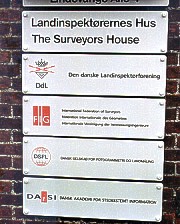 |
International Federation of Surveyors Lindevangs Allé 4 DK-2000 Frederiksberg Copenhagen, Denmark E-mail: FIG@fig.net Tel. +45 3886 1081 Fax +45 3886 0252 Director: Markku Villikka FIG home page: http://www.fig.net |
|
|
| Note | Swiss francs | Swiss francs | |
| Income | |||
| Subscriptions, member associations |
1 |
269,761 | |
| Subscriptions, institutional correspondents | 1,170 | ||
| Subscriptions, sponsor members | 38,862 | ||
| Sales of publications |
456 |
||
|
310,249 |
|||
| Expenditure | |||
| Bureau administration | 40,343 | ||
| Bureau meetings | 15,821 | ||
| FIG meetings | 51,562 | ||
| Member support | 55,262 | ||
| Commission activity | 36,819 | ||
| Promotion | 15,697 | ||
| Permanent office start/up costs |
19,894 |
||
| 235,398 | |||
| Surplus for the year |
74,851 |
||
|
310,249 |
|||
| Note 1. Includes part payments and arrears Subscriptions (including arrears) outstanding as at 31.12.1998 - Swiss francs 50,484. |
|||

|
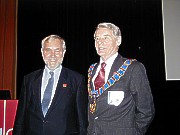 |
Peter Dale, President of FIG 1995–1999 (left) and
Robert W. Foster, |
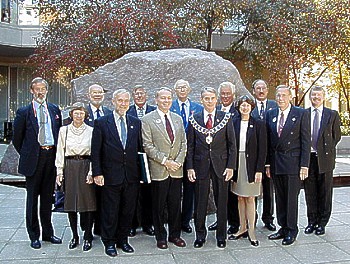 |
The UK and US Bureaux together at the handover ceremony in Washington, D.C. |
Published by the International Federation of Surveyors FIG
ISSN 1081-6522
ISBN 87-90907-05-1
Material from this Annual Review may be reproduced freely.